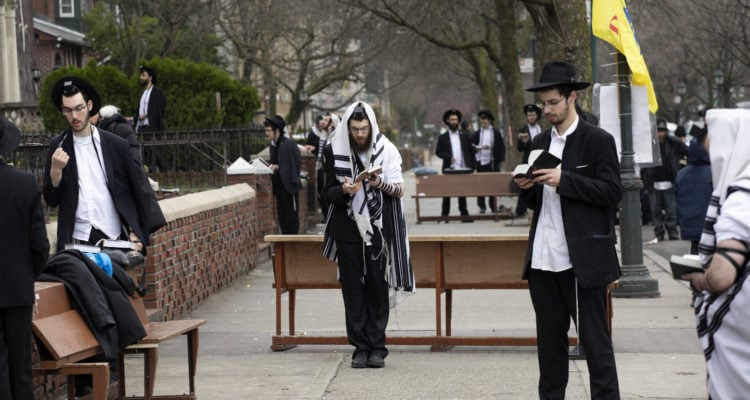 16 MAJA 1943. ROCZNICA WYSADZENIA WIELKIEJ SYNAGOGI W WARSZAWIE
16 MAJA 1943. ROCZNICA WYSADZENIA WIELKIEJ SYNAGOGI W WARSZAWIE
Żydowski Instytut Historyczny
Wielka Synagoga w Warszawie istniała bardzo krótko, niecałe 65 lat. Jej uroczyste otwarcie miało miejsce 26 września 1878 roku. Wysadzenie w powietrze przez oddziały SS, tłumiące powstanie w getcie, miało symbolizować koniec żydowskiej Warszawy.
 Ruiny Wielkiej Synagogi w Warszawie
Ruiny Wielkiej Synagogi w Warszawie
W 1872 r. Plac Tłomackie został zakupiony przez Komitet Synagogi i powołany przez niego komitet budowy. Projekt i realizację zamówiono u Leandro Marconiego, ówcześnie najlepszego i najdroższego architekta warszawskiego, autora m.in. budynku Banku Handlowego przy ul. Traugutta 7 czy Pałacu Pod Karczochem w Alejach Ujazdowskich, współtwórcy – wraz z ojcem Henrykiem – Hotelu Europejskiego przy Krakowskim Przedmieściu. Po wyburzeniu istniejących budynków z XVIII w. rozpoczęto prace budowlane. Budowa trwała dwa lata, a powstały obiekt mógł pomieścić 2200 osób. W synagodze odbywały się nabożeństwa także z okazji ważnych świąt państwowych, takich jak Święto Konstytucji 3 Maja i Święto Niepodległości 11 listopada. W pomieszczeniu zwolnionym przez służącego utworzono — na początku skromną — Główną Bibliotekę Judaistyczną, która w 1936 r. przeniosła się do nowego Budynku przy Tłomackiem 5.
W styczniu 1940 r. Niemcy zamknęli synagogę. W 1942 r. urządzili w niej – podobnie jak w sąsiednim budynku biblioteki – skład mebli zrabowanych z żydowskich domów. Wysadzenie w powietrze synagogi, po długotrwałych przygotowaniach, miało być symbolicznym zakończeniem żydowskiej obecności w Warszawie. Aktu zniszczenia dokonał osobiście kat warszawskiego getta, SS-Brigadeführer Jürgen Stroop 16 maja 1943 r. Kazimierz Moczarski zapisał w Rozmowach z katem słowa Stroopa, który jeszcze w więzieniu mokotowskim wielokrotnie wspominał to wydarzenie: „Przygotowania trwały 10 dni. Synagoga była gmachem solidnie zbudowanym. Stąd, aby ją za jednym zamachem wysadzić w powietrze, należało przeprowadzić pracochłonne roboty saperskie i elektryczne. Ależ to był piękny widok! Z punktu widzenia malarskiego i teatralnego obraz fantastyczny. Oficer saperów wręczył mi aparat elektryczny, wywołujący detonację ładunków wybuchowych. Przedłużałem chwilę oczekiwania. Wreszcie krzyknąłem: Heil Hitler! – i nacisnąłem guzik. Ognisty wybuch uniósł się do chmur. Przeraźliwy huk. Bajeczna feeria kolorów. Niezapomniana alegoria triumfu nad żydostwem. Getto warszawskie skończyło swój żywot”.
„Odpryski murów i kamienie dolatywały aż na Długą do Arsenału – pisał Henryk Kroszczor, naoczny świadek – a szczątki książek i kawałki papieru aż na sąsiednią ulicę”. „Jedynymi pamiątkami po najznamienitszej warszawskiej budowli żydowskiej są część kolumny i numerek z szatni” – napisał Jan Jagielski.
Po wojnie synagogi nie odbudowano – w latach 60. rozpoczęto budowę Błękitnego Wieżowca, który ukończono w 1991 r.
Źródła:
Jan Jagielski, Trzy synagogi
Henryk Kroszczor, Wielka synagoga na Tłomackiem, w: „Biuletyn Żydowskiego Instytutu Historycznego” nr 3(95)/1975, s. 3–16.Ewa Małkowska, Synagoga na Tłomackiem, Warszawa 1991.
Kazimierz Moczarski, Rozmowy z katem, wstęp Norman Davies, opracował Andrzej Krzysztof Kunert, Kraków 2007.
 Model Wielkiej Synagogi, Diaspora Museum, Tel Awiw
Model Wielkiej Synagogi, Diaspora Museum, Tel Awiw
Sodabottle, Wikimedia Commons, CC BY-SA 3.0.
Zawartość publikowanych artykułów i materiałów nie reprezentuje poglądów ani opinii Reunion’68,
ani też webmastera Blogu Reunion’68, chyba ze jest to wyraźnie zaznaczone.
Twoje uwagi, linki, własne artykuły lub wiadomości prześlij na adres:
webmaster@reunion68.com





